Hello, fellow gardeners! Are you wondering why your raspberry bushes are not producing any fruit? It can be frustrating when you eagerly anticipate a bountiful harvest, only to be disappointed by empty bushes. But fear not! I’m here to provide you with some tips and fixes to help solve this raspberry plant mystery.
Raspberry bush care involves understanding the growth and fruit production cycle of these delicious berries. Pruning techniques, proper growing conditions, and pest and disease management all play a crucial role in ensuring abundant fruit production. Let’s dive into the details and address the potential issues that may be hampering your raspberry plant’s productivity.
Key Takeaways:
- No fruit on raspberry bushes can be caused by various factors.
- Understanding raspberry growth and fruit production is key to addressing the issue.
- Common reasons for no fruit include improper pruning, growing conditions, pests, and diseases.
- Troubleshooting growing conditions, managing pests and diseases, and proper nutrient management are essential.
- Short raspberry plants and common fruit disorders can indicate underlying problems.
Understanding Raspberry Growth and Fruit Production
As an avid gardener, I have always been fascinated by the growth and development of plants. One particular plant that has captivated my interest is the raspberry bush. Understanding how raspberries grow and produce fruit is essential for any raspberry enthusiast. Let’s delve into the intriguing world of raspberry plant growth and fruit production.
Raspberry Plants: Perennial Wonders with Biennial Canes
Raspberries, classified as perennial plants, have an interesting growth cycle. They produce fruit on biennial canes, which means that the canes have a two-year life span. In the first year, the canes focus on vegetative growth and do not produce fruit. However, they play a crucial role in establishing a strong root system and preparing for future fruit production.
Once the second year rolls around, the biennial canes are ready to impress. The everbearing raspberry canes bear fruit in the fall of their first year and again in the summer of their second year. On the other hand, summer-bearing raspberries only produce fruit on second-year canes. These differences in fruiting behavior inform an essential aspect of raspberry cultivation: pruning.
Pruning: Unleashing the Full Potential of Raspberry Plants
Pruning techniques are vital for maximizing raspberry fruit production. By selectively removing specific canes, we can encourage the growth of new canes that will bear fruit in the following years. The timing and method of pruning depend on the type of raspberry plant.
For everbearing raspberries, it’s best to prune all canes to the ground in late winter or early spring. This will allow the new canes to grow and produce fruit in the fall. In contrast, summer-bearing raspberries require a different approach. To promote fruit production, prune the second-year canes after they have finished bearing fruit, leaving the first-year canes intact for the following year.
Visualizing Raspberry Growth and Fruit Production
To help you visualize the growth cycle of raspberry plants and understand their fruit production patterns, take a look at the following table:
| Raspberry Type | First-Year Cane | Second-Year Cane | Fruit Production |
|---|---|---|---|
| Everbearing Raspberries | No fruit | Fruit in fall | Fruit again in summer |
| Summer-Bearing Raspberries | No fruit | Fruit in the following summer | No fruit |
This table illustrates the growth and fruit production patterns of everbearing and summer-bearing raspberries. It’s essential to understand these nuances when caring for your raspberry bushes, as improper pruning can significantly impact fruit yield.
Now that we have gained a deeper understanding of raspberry growth and fruit production, we are equipped with the knowledge needed to cultivate thriving raspberry plants. In the next section, we will explore common reasons for the lack of fruit on raspberry plants and how to address them. Stay tuned!
Common Reasons for No Fruit on Raspberry Plants
If your raspberry plants aren’t producing fruit, there could be several common reasons for this issue. It’s important to address these factors in order to improve fruit production. The main reasons for the lack of fruit on raspberry plants include improper pruning, improper growing conditions, pests, and diseases.
Improper Pruning
One of the common reasons for no fruit on raspberry plants is improper pruning. Pruning plays a crucial role in promoting fruit production in raspberry plants. It’s important to understand the proper pruning techniques specific to the type of raspberry plant you have. This includes not pruning first-year canes and properly pruning second-year canes to encourage the growth of new canes that will produce fruit.
Improper Growing Conditions
The growing conditions for raspberry plants can greatly impact fruit production. Inadequate sunlight or water can prevent the plants from producing fruit. Raspberry plants require a minimum of 6 hours of direct sunlight per day and adequate water, typically around 1 inch of rain per week. Without these optimal growing conditions, fruit production can be negatively affected.
Pests and Diseases
Pests and diseases are another factor that can contribute to the lack of fruit on raspberry plants. Common pests that can affect raspberry plants include aphids, spider mites, and raspberry cane borers. These pests can cause damage to the plants and inhibit fruit production. Additionally, diseases such as powdery mildew can also impact raspberry plant health and fruit production.
To address these issues, it’s important to properly identify and manage pests and diseases. Implementing pest control measures and taking preventive actions, such as promoting good plant health and providing proper irrigation, can help ensure the productivity of raspberry plants.
Troubleshooting Growing Conditions for Raspberry Plants
Creating optimal growing conditions for raspberry plants is essential for their overall health and productivity. Let’s explore the key factors to consider when troubleshooting and improving the growing conditions:
Raised Beds for Improved Drainage
Growing raspberries in raised beds can provide several benefits, including improved drainage. Poorly drained soil can lead to root rot and other moisture-related issues. By elevating the soil level, excess water can easily drain away, preventing waterlogging and promoting healthy root growth.
Providing Adequate Sunlight
Sunlight is crucial for the growth and fruit production of raspberry plants. They require a minimum of 6 hours of direct sunlight per day to thrive. Planting them in a location with full sun exposure will ensure optimal development and yield.
Proper Watering Techniques
Watering plays a vital role in maintaining the moisture balance for raspberry plants. Consistent and adequate watering is necessary, especially during dry spells. Aim to provide approximately 1 inch (2.5 cm) of rain or equivalent irrigation per week. Be careful not to overwater, as it can lead to root rot and other fungal diseases.
Ensuring Soil Fertility
Healthy raspberry plants require fertile soil that is rich in nutrients. Conduct a soil test to assess its fertility levels and pH balance. Based on the results, amend the soil with organic matter, such as compost or well-rotted manure, to improve its nutrient content and structure.
By troubleshooting and optimizing these growing conditions, you can create an ideal environment for your raspberry plants to flourish. Now, let’s take a closer look at a table summarizing the key growing conditions for raspberry plants:
| Growing Conditions | Description |
|---|---|
| Raised Beds | Provide improved drainage and prevent waterlogging. |
| Sunlight | Minimum of 6 hours of direct sunlight per day. |
| Watering | Aim for approximately 1 inch (2.5 cm) of rain per week, avoiding overwatering. |
| Soil Fertility | Ensure soil is rich in nutrients by incorporating organic matter. |
Identifying and Managing Raspberry Plant Pests and Diseases
When it comes to maintaining the health and productivity of raspberry plants, it’s essential to be aware of the potential pests and diseases that can affect them. By identifying and managing these issues effectively, you can ensure that your raspberry bushes remain in optimal condition and continue to produce abundant fruit.
Common Raspberry Plant Pests
Raspberry plants can fall victim to a variety of pests that can cause damage and hinder fruit production. Here are some of the most common raspberry plant pests:
- Aphids: These small insects can infest raspberry plants and suck sap from the leaves and stems, causing them to curl and distort.
- Spider Mites: These tiny arachnids can create fine webs on the undersides of leaves and suck the sap from raspberry plants, leading to yellowing and stunted growth.
- Raspberry Cane Borer: The adult cane borers lay eggs on raspberry canes, and the resulting larvae burrow into the canes, causing them to wither and die.
Effective pest management strategies, such as regular inspection, using barriers or insecticides, and encouraging natural predators, can help control these pests and minimize their impact on your raspberry plants.
Common Raspberry Plant Diseases
Raspberry plants are susceptible to several diseases, which can significantly affect their overall health and fruit production. Here are some of the most common raspberry plant diseases:
- Powdery Mildew: This fungal disease results in a white, powdery coating on the leaves and stems of raspberry plants, reducing their ability to photosynthesize and weakening their overall health.
“Powdery mildew can be particularly detrimental to raspberry plants, reducing their vigor and fruit quality. Regular monitoring and the use of fungicides can help manage this disease effectively.” – Expert Gardener
Identifying raspberry plant diseases early on and implementing appropriate disease management practices, such as pruning affected areas, improving air circulation, and using fungicides when necessary, can help prevent the spread and minimize the impact of these diseases on your raspberry bushes.
Visual Reference: Common Raspberry Plant Pests and Diseases
| Raspberry Plant Pests | Raspberry Plant Diseases |
|---|---|
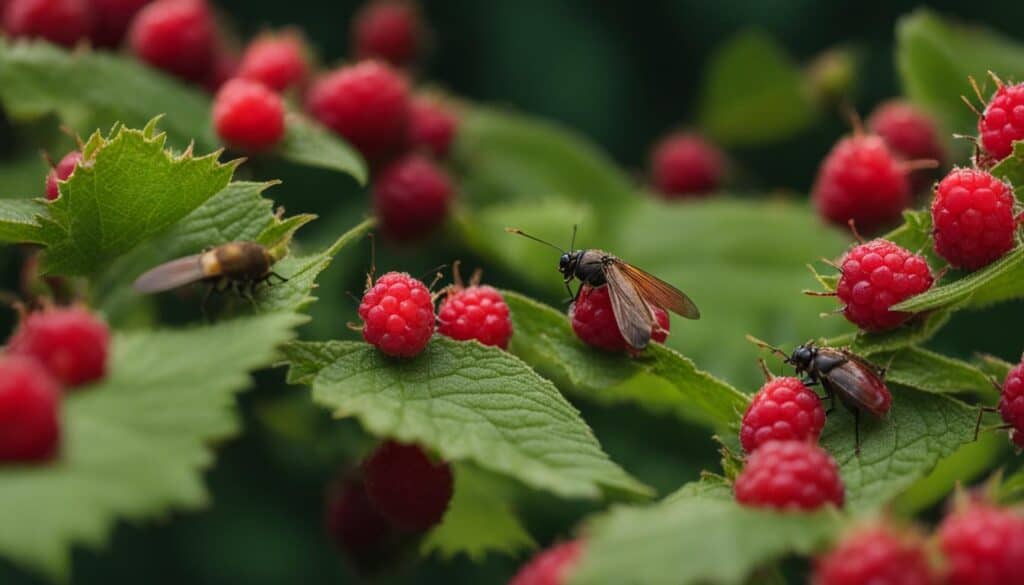 |
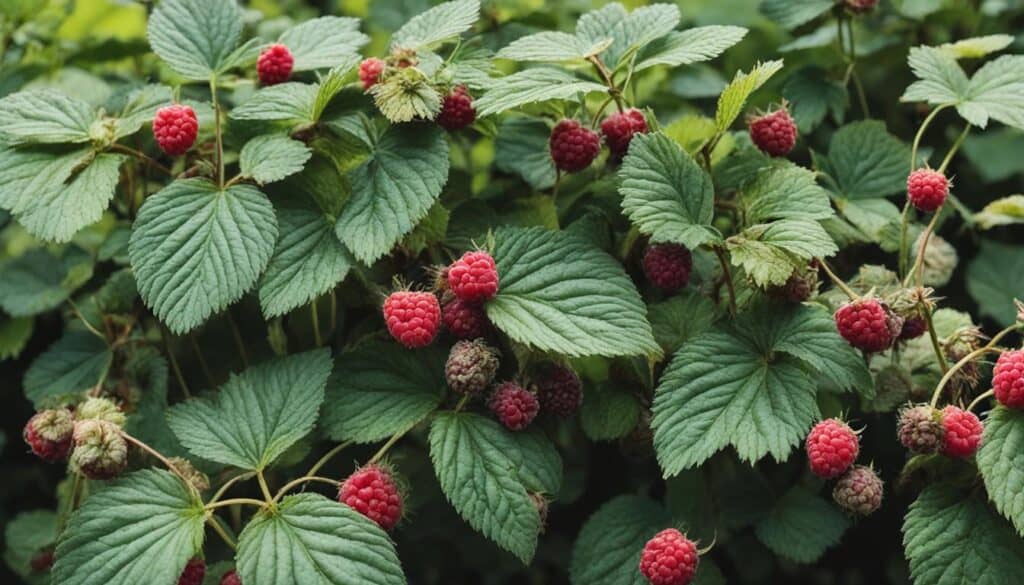 |
Remember that prevention and early detection are key when it comes to managing raspberry plant pests and diseases. Regular inspection, proper plant care, and prompt intervention can go a long way in maintaining the health and productivity of your raspberry bushes.
Troubleshooting Improper Watering
Improper watering is a common issue that can hinder the growth and fruit production of raspberry plants. It is important to understand the different challenges associated with both under-watering and over-watering in order to ensure proper care for your plants.
Under-Watering
Under-watering, or not providing enough water to your raspberry plants, can lead to stunted growth and reduced fruit production. It is crucial to maintain proper soil moisture levels to support the plant’s health.
One effective way to determine when your raspberry plants need watering is to check the top 2-4 inches of soil. If it feels dry to the touch, it’s time to water. Deep, infrequent watering is preferable to shallow, frequent watering, as it encourages the roots to grow deeper and helps establish a strong and healthy plant.
Additionally, using mulch around the base of the plants can help retain moisture, prevent evaporation, and maintain a more consistent soil moisture level.
Over-Watering
On the other hand, over-watering can be just as detrimental to raspberry plants as under-watering. Excessive moisture can lead to root rot, fungal diseases, and overall poor plant health.
To prevent over-watering, ensure that the soil has proper drainage. Raspberry plants thrive in well-draining soil, and excess moisture should be able to flow away from the roots. Adding compost to the soil can improve drainage and create a healthier root environment.
To further prevent over-watering, allow the top few inches of the soil to dry out before watering again. This will help avoid waterlogged conditions and encourage the roots to seek out moisture deeper in the soil.
| Signs of Under-Watering | Signs of Over-Watering |
|---|---|
|
|

|
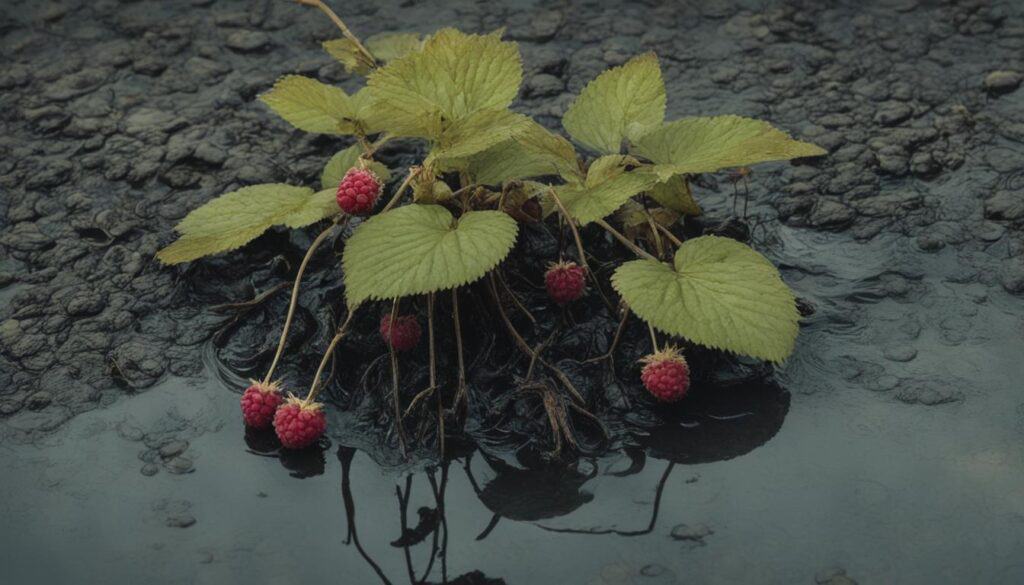
|
Proper watering is crucial for healthy raspberry plants. Finding the right balance between under-watering and over-watering will support optimal growth and fruit production.
Addressing Heat and Frost Stress
Raspberry plants are native to temperate climates and can be susceptible to heat and frost stress. These stressors can negatively impact plant health and reduce fruit production. To ensure the well-being of your raspberry bushes, it’s important to address these challenges effectively.
Heat Stress
Heat stress occurs when raspberry plants are exposed to high temperatures for extended periods. This can lead to leaf wilting, decreased fruit set, and reduced overall plant growth. To mitigate heat stress, consider the following strategies:
- Provide adequate shading: Shield your raspberry plants from intense sunlight by installing shade cloth or placing them under trees or structures to reduce direct exposure.
- Ensure proper hardiness zone compatibility: Choose raspberry varieties that are suited for your specific climate conditions, considering factors such as heat tolerance and recommended hardiness zones.
Frost Stress
Frost stress occurs when raspberry plants are exposed to freezing temperatures, which can cause damage to the plant’s tissues. To protect your raspberry bushes from frost stress, consider the following measures:
- Cover plants during cold nights: Use fabric covers or garden blankets to shield your raspberry plants from frost during chilly nights.
- Plant in raised beds: Raised beds tend to have better drainage and can help prevent frost damage by allowing excess water to drain away from the plant roots.
By addressing heat and frost stress, you can enhance the resilience of your raspberry plants and improve their fruit production. Take proactive steps to provide shade in hot climates and protect against freezing temperatures to ensure the health and productivity of your raspberry bushes.
Nutrient Management for Raspberry Plants
Nutrient deficiencies or excesses can significantly impact the growth and fruit production of raspberry plants. Proper nutrient management is essential for ensuring optimal plant health and maximizing fruit yield. By providing the right balance of nutrients, utilizing fertilizers, compost, and mulch, you can promote vigorous growth and enhance the quality of your raspberries.
The Importance of Nutrient Balance
Like all plants, raspberries require a balanced supply of nutrients for their growth and development. A deficiency in essential nutrients can weaken the plants, stunt their growth, and reduce fruit production. On the other hand, excessive nutrient levels can also be detrimental, leading to imbalances and potential toxicity issues.
“Optimizing the nutrient balance is crucial to ensure that your raspberry plants thrive and produce abundant, flavorful fruit.”
Using Fertilizers
Fertilizers are a valuable tool in managing the nutrient needs of raspberry plants. They provide a concentrated source of essential elements that may be lacking in the soil. When selecting a fertilizer, choose one formulated specifically for berries or fruits. Look for products with a balanced ratio of nitrogen (N), phosphorus (P), and potassium (K), as indicated by the N-P-K numbers on the packaging. A general recommendation for raspberry plants is a fertilizer with an N-P-K ratio of 10-10-10 or 14-14-14.
Apply fertilizers according to the manufacturer’s instructions, typically in early spring before new growth begins. Avoid over-fertilization, as excessive nitrogen can promote vegetative growth at the expense of fruit production. It’s crucial to strike a careful balance to provide adequate nutrition without causing nutrient imbalances or damaging the environment.
The Benefits of Compost
Compost is a natural and organic amendment that enriches the soil with a wide range of beneficial nutrients. It improves soil structure, enhances moisture retention, and supports the growth of beneficial microorganisms. Incorporating compost into the planting area before establishing raspberry plants can help provide a nutrient-rich environment for their development.
Apply compost around the base of the plants, avoiding direct contact with the stems. This will replenish the soil with nutrients gradually while promoting microbial activity. Aim for an even layer of compost that is around 2-3 inches thick. As the compost breaks down, it releases nutrients slowly, providing a sustained source of nutrition for the raspberry plants throughout the growing season.
The Role of Mulch
Mulching is another beneficial practice that aids in nutrient management for raspberry plants. Applying a layer of mulch around the base of the plants helps to conserve moisture, suppress weed growth, and regulate soil temperature. Organic mulch, such as straw, wood chips, or shredded leaves, decomposes over time, enriching the soil with nutrients and organic matter.
Spread mulch around the plants, ensuring it covers the soil surface in a 2-3 inch layer. Keep the mulch a few inches away from the stems to prevent moisture-related problems or pest issues. Mulching not only helps retain moisture and control weeds but also improves soil fertility, making it an essential component of nutrient management in raspberry plant care.
The image shows healthy, thriving raspberry plants and the potential abundance of fruit they can produce when managed properly.
By implementing a comprehensive nutrient management program, including balanced fertilization, the use of compost, and mulching, you can optimize the nutrient supply for your raspberry plants. These practices foster healthy growth, robust fruit production, and ultimately, a plentiful harvest of delicious raspberries.
Common Issues with Short Raspberry Plants
If your raspberry plants are growing shorter than expected, it could be a sign of various underlying issues. Short raspberry plants often indicate unsuitable growing conditions, such as heavy soils or xeric environments, as well as crowded conditions, poor soil fertility, insufficient sunlight, and the presence of pests.
Heavy soils can restrict root development and make it challenging for plants to absorb nutrients effectively. In xeric environments, where water availability is limited, raspberry plants may struggle to meet their hydration needs, resulting in stunted growth.
Crowded conditions can also contribute to shorter raspberry plants. When plants are too close together, they compete for resources like water, nutrients, and sunlight, leading to reduced growth and development.
Poor soil fertility is another potential factor. If the soil lacks essential nutrients, plants may not have the necessary resources to grow to their full potential.
Insufficient sunlight is a common issue that can hinder raspberry plant growth. Raspberry plants require at least 6 hours of direct sunlight per day to thrive. If they are not receiving enough sunlight, their growth may be stunted, resulting in shorter plants.
Pests such as aphids, spider mites, or raspberry cane borers can also cause damage to raspberry plants, leading to poor growth and shorter stature.
To address these issues and promote healthy raspberry plant growth and fruitful production:
- Amend heavy soils with organic matter, such as compost, to improve drainage and nutrient availability.
- In xeric environments, consider implementing irrigation solutions to ensure adequate water supply for the plants.
- Thin out crowded raspberry plants to provide sufficient space for each plant to grow and thrive.
- Optimize soil fertility by adding balanced fertilizers or organic amendments to provide necessary nutrients.
- Ensure that raspberry plants receive adequate sunlight by choosing a suitable planting location and avoiding shady areas.
- Implement pest management strategies, such as using organic insecticides or natural predators, to control pests that may be affecting plant growth.
By addressing these common issues, you can help your raspberry plants overcome growth limitations and encourage them to reach their full potential, resulting in healthier plants and abundant fruit production.
Pest and Disease Management for Raspberry Plants
When it comes to maintaining the health and productivity of your raspberry plants, it’s essential to address common pests and diseases that can affect their overall well-being and the quality of their fruits. By implementing effective pest and disease management practices, you can ensure that your raspberry plants thrive and produce abundant, delicious berries.
Spider Mites: A Common Menace
Spider mites are tiny arachnids that can wreak havoc on raspberry plants. These minuscule pests feed on the sap of the plant, causing damage to the leaves and stems. To identify spider mite infestations, look out for tiny webs and yellowish speckles on the plant’s surface.
Controlling spider mites requires a multifaceted approach. Regularly spraying your plants with a forceful stream of water can help dislodge and remove them. Additionally, introducing natural predators like ladybugs into your garden can help keep spider mite populations in check. If the infestation persists, using horticultural oils or insecticidal soaps can provide effective control.
Raspberry Cane Borer: A Silent Threat
The raspberry cane borer is another common pest that can cause significant damage to raspberry plants. The adult borers are clear-winged moths that lay eggs on the raspberry canes. The hatched larvae then tunnel into the canes, causing weak, wilted, or dying canes.
Preventing raspberry cane borer infestations starts with inspecting your plants for signs of damage and carefully removing and destroying affected canes. Pruning and burning or burying the infested canes can effectively prevent further damage. Applying insecticides specifically designed to target cane borers can also offer effective control.
Protecting Against Sunscald and Heat Stress
Raspberry plants are susceptible to sunscald and heat stress, especially in hot summer climates. Sunscald occurs when intense sunlight causes damage to the exposed parts of the plant, leading to sunburned and discolored fruit. Heat stress, on the other hand, results from extended periods of high temperatures and can cause poor fruit set and reduced fruit quality.
To protect your raspberry plants from sunscald and heat stress, providing adequate shading is crucial. Consider using shade cloth or planting taller companion plants to block out excessive sunlight. Regularly watering your plants, especially during heatwaves, can also help cool them down and prevent heat stress.
Addressing Fruit Disorders
Raspberry plants can sometimes develop fruit disorders, which can affect the appearance and quality of the berries. Common fruit disorders include fruit cracking, misshapen fruits, and berry malformation.
To minimize fruit disorders, it’s important to maintain consistent watering and ensure that your plants receive adequate nutrients. Avoid over-watering, as excessive moisture can contribute to fruit cracking. Regularly inspect your plants and remove any misshapen or malformed fruits to prevent the spread of disorders.
Implementing proactive pest and disease management strategies is vital for the health and productivity of your raspberry plants. Regular monitoring, prompt action, and maintaining optimal growing conditions can go a long way in ensuring that your raspberry bushes thrive and produce bountiful, flavorful fruits.
Conclusion
Improving raspberry fruit production requires troubleshooting and addressing common issues that affect raspberry plant growth. By understanding the specific needs of raspberry plants, gardeners can enhance productivity and enjoy a bountiful harvest.
To improve raspberry plant productivity, it is crucial to identify and manage pests and diseases that can hinder growth and fruit production. Regular monitoring and appropriate pest and disease management practices, such as proper watering, pruning, and providing shade, can help control these issues effectively.
Additionally, ensuring optimal growing conditions is essential for maximizing raspberry fruit production. Providing a well-drained, nutrient-rich soil, along with the right amount of sunlight and water, is key to promoting healthy plant growth and abundant fruit production.
By troubleshooting raspberry plant problems, gardeners can overcome challenges and create an ideal environment for raspberry plants to thrive. With proper care and attention, the productivity of raspberry plants can be significantly improved, resulting in a delicious and satisfying harvest.
FAQ
Why are my raspberry bushes not fruiting?
There can be several reasons why your raspberry bushes are not fruiting. Some common factors include improper pruning, inadequate growing conditions, pests, and diseases. By addressing these issues, you can improve raspberry fruit production.
How can I increase raspberry fruit production?
To increase raspberry fruit production, you can focus on proper pruning techniques, ensuring optimal growing conditions such as sunlight and water, managing pests and diseases, and maintaining soil fertility. These measures will promote healthy raspberry plants and enhance fruit production.
What are some tips for raspberry plant care?
Proper raspberry plant care involves regular pruning, providing adequate sunlight and water, managing pests and diseases, and maintaining soil fertility. By following these tips, you can ensure the health and productivity of your raspberry plants.
How can I troubleshoot raspberry plant problems?
Troubleshooting raspberry plant problems involves identifying the root cause of issues such as no fruit production, stunted growth, or pest infestations. By addressing factors like pruning mistakes, improper growing conditions, and pest management, you can effectively troubleshoot and resolve raspberry plant problems.
What are some common diseases that affect raspberry plants?
Raspberry plants can be susceptible to diseases such as powdery mildew and raspberry cane borer. These diseases can affect plant health and fruit production. Implementing appropriate disease management practices will help prevent and control these issues.
How should I water raspberry plants?
It’s important to maintain proper soil moisture for raspberry plants. Watering when the top 2-4 inches of soil is dry and ensuring good soil drainage through compost and mulch will help avoid both under-watering and over-watering, promoting healthy plant growth and fruit production.
What can I do to protect raspberry plants from heat and frost stress?
Heat stress and frost stress can impact raspberry plant health and fruit quality. Providing adequate shading in hot climates and ensuring proper hardiness zone compatibility can help mitigate these stressors and promote healthy fruit production.
How do I manage nutrient deficiencies or excesses in raspberry plants?
Nutrient deficiencies or excesses can affect raspberry plant growth and fruit production. Proper nutrient management, including balanced fertilization, the use of compost, and mulching, is essential for ensuring optimal plant health and fruit production.
What are some common issues with short raspberry plants?
Short raspberry plants can indicate various issues such as heavy soils, xeric environments, crowded conditions, poor soil fertility, insufficient sunlight, or the presence of pests. Addressing these issues is crucial for promoting healthy raspberry plant growth and fruit production.
How can I manage pests and diseases in raspberry plants?
Common pests and diseases that can affect raspberry plants include spider mites, raspberry cane borer, and sunscald. Implementing appropriate pest and disease management practices, including adequate watering, pruning, and providing shade, can help control these issues and ensure plant health.
How can I improve raspberry plant productivity?
To improve raspberry plant productivity, it’s important to troubleshoot and address common issues such as improper pruning, growing conditions, pests, and diseases. By understanding the specific needs of raspberry plants and implementing necessary measures, you can enhance fruit production and enjoy a bountiful harvest.

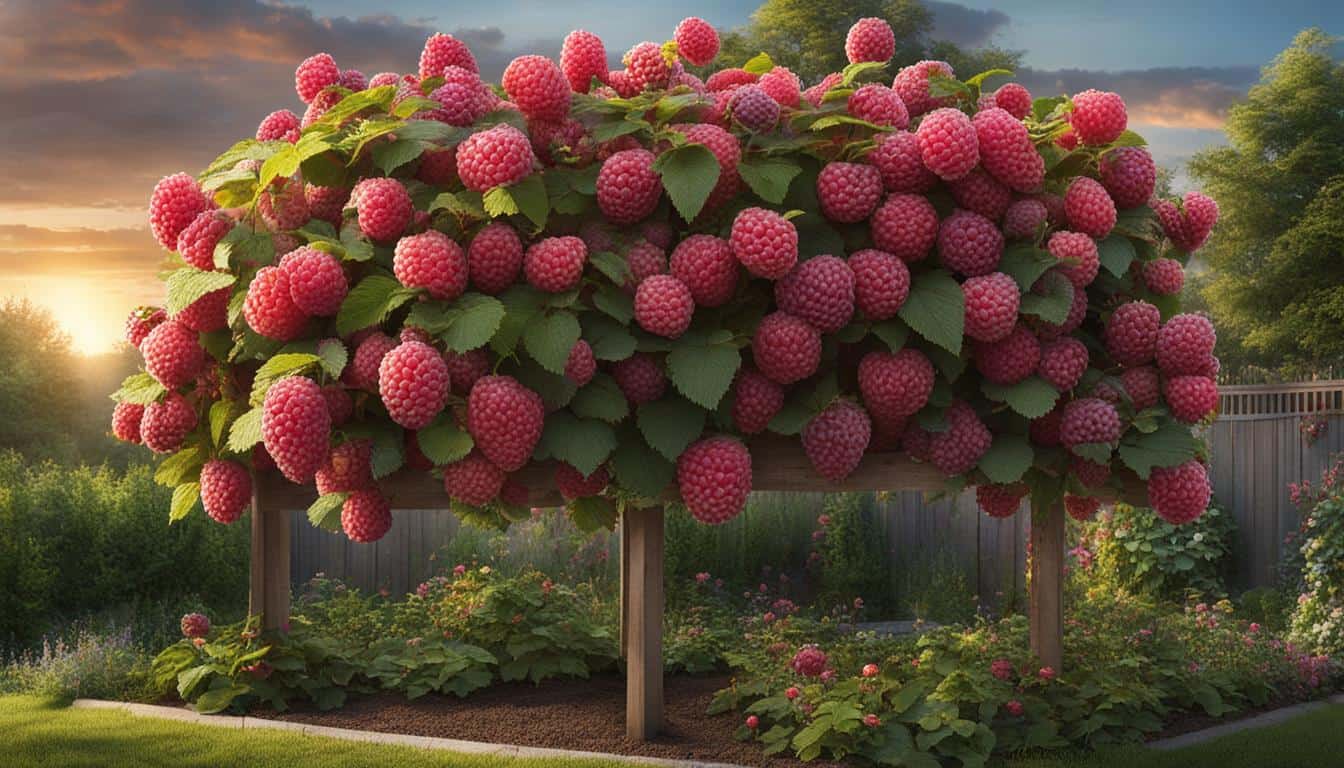
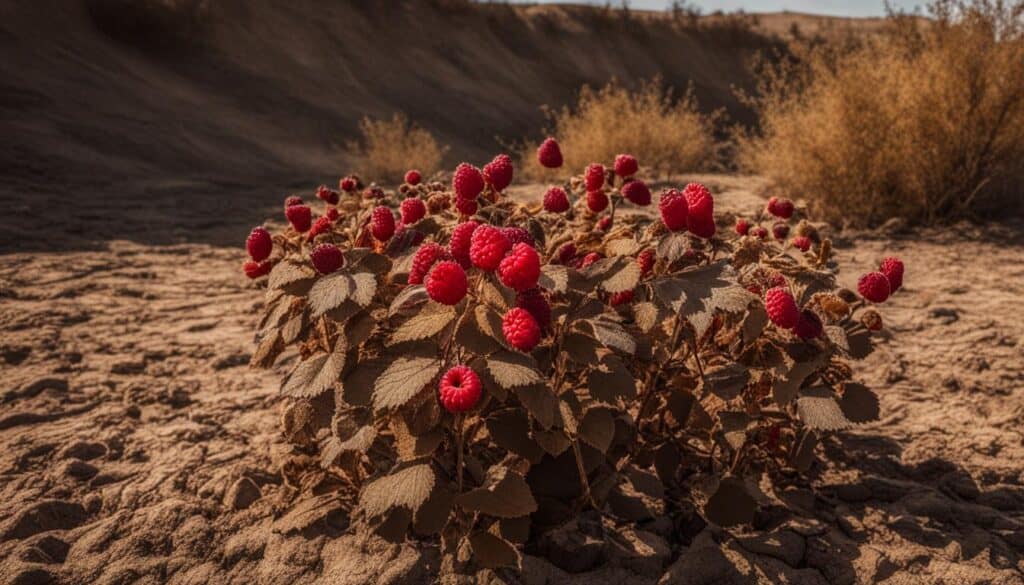



Leave a Reply